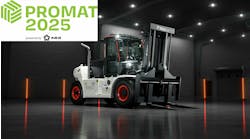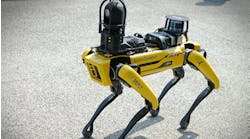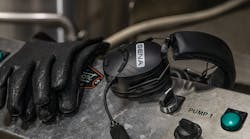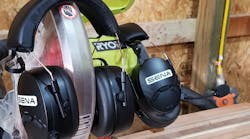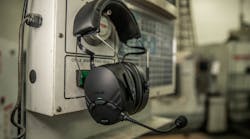Latest from Safety
Communication is important in so many worksite settings. However, when it comes to heavy equipment operators and loud industrial settings, it can mean the loss of digits or other very dangerous physical situations.
When clear communication is had between workers at the jobsite, it not only improves communication but can complete the job in a shorter amount of time with greater quality—as managers can express their clear expectations immediately without having to turn off a noisy machine or perhaps get on a forklift to get to the precise location of the worker with a question.
According to the Bureau of Labor Statistics, heavy construction had the greatest number of fatalities, at 1,008 in 2020. Often, on-the-job accidents are occurring due to breakdowns in communication. When multiple crew members are on a job site with heavy equipment and/or potentially dangerous operations, precision and attention cannot afford to be missed nor can any instructions be misunderstood.
Communication Improvements
Communication can be hampered by the very equipment that the worker is using to protect themselves: foam earplugs, earmuffs, and headsets. In order to talk to a foreman, workers would need to remove hearing protection and perhaps shout over the loud equipment—or use hand signals memorized ahead of time.
These are far from reliable—especially if there isn’t a clear line of sight. The intermittent stopping of work for ten minutes or more at a time can subsequently add up to hours in a day. These hours can quickly double or triple if there are numerous co-workers and operations impacted.
Additionally, interruptions occurring a few dozen times can also become quickly frustrating and affect how the entire team works together and the team’s ability to complete projects on deadline.
Industrial, manufacturing, and heavy construction site safety improves when crews wear wireless headsets to communicate. It allows workers to communicate while continuing a project. And when an “all-stop” is called, everyone hears it instantly. Those extra seconds of reaction time can mean the difference when lives are at risk and expensive equipment could be damaged or rendered inoperable.
Productivity gets a boost when workers don’t have to stop working to discuss how issues are being solved, such as positioning equipment correctly or where to maneuver a forklift or coordinating a complex operation.
Two-way radios are certainly an improvement over yelling across the construction site or using hand signals. However, there are limitations with having to pull out a radio and perhaps push a button and wait for your turn to speak. New technologies take communication to a safer, more productive level.
Advanced wearable intercom systems are ideal for heavy equipment and construction teams as well as industrial manufacturing, providing hearing protection; hands-free communication (including voice commands to the system); the ability to effortlessly split into smaller groups and then rejoin; and a full-day, continuous-use battery.
Smart communication devices can be integrated with headbands or with hard hat mounts to enable highly fluid team communication. Additionally, teams prefer dynamic mesh communications that work with an unlicensed band versus the traditional 2-way radio com systems that are generally subscription-based.
Boosting Worker Safety with Mesh Communication
Mesh communication systems use a wireless mesh network and create rich interconnections among communication devices. The communications network can now be completely autonomous (no base stations are necessary) and always on, so users don’t need to press a button to speak.
When using dynamic mesh communications, a self-healing network can be created, connecting up to 15 users within a two-mile range. Multiple teams can be accommodated within a target territory by assigning each to one of many available channels. Users are alerted when their connection to the network is out of range and are automatically added back into the group when they come back into range.
Worker safety is greatly enhanced with these technological advances in wearable communication systems because they provide situational awareness while protecting against loud noise levels. The compatibility of this new networking topology with noise protection hardware provides teams with a one-two punch for safety, productivity, and profitability.
When ear protection is switched on, it reduces ambient noise to 82 decibels but lets through important sounds like warning signals. Construction and industrial workers can finally get relief from their loud operations such as working with asphalt, excavators, forklifts, grinders, bulldozers, and heavy machinery.
According to the CDC’s noise study, bulldozer operators consistently had the highest noise exposures, ranging from a US National Institute for Occupational Safety and Health Recommended Exposure Limit (NIOSH REL) dose of 844 to 25,836% and an OSHA PEL (Permissible Exposure Limit) dose of 139 to 1,397%. However, all industrial workers can benefit from enhanced communication with noise protection.
Intelligent communication systems mean voice commands can be used rather than pushing a button or other manuals processes that take attention from the job. Commands such as “volume up,” “mute mic” or “battery status” enable the user to better control the communication options. Dynamic mesh is a self-optimizing and self-healing network, so if one unit disconnects, the rest of the group stays connected. Once that unit comes back within range, it automatically reconnects to the group.
While most of these systems are designed to enable team communication, a private chat is also available and can be set up via a mobile application. Either through voice activation or the click of a contact name, a team lead can be connected to a single worker to have a completely private conversation.
FM radio and Bluetooth are also built into these evolved systems, letting workers listen to the radio, receive phone calls or stream music without removing their headgear. These options can be disabled by those in charge whenever necessary to enable the safest and most efficient worksites. Such systems are highly resistant to water and dust (IP54) and include emergency notification capabilities as well.
In addition to voice activation, there is the ability to hear the volume at which the user is speaking using a self-hearing/sidetone.
A New Best Practice
Industrial and heavy equipment operators often find themselves in a vicious circle since the protection they wear to protect against hearing damage from noisy equipment can make communication difficult. Continuous exposure to loud noises can be stressful on the mind and body.
Lowering sound levels makes worksites less chaotic, which improves both precision and accuracy. Wireless communication headsets enable clear communication with crews at all times, lower loud noises, and eliminate the need for shouting.
Heavy equipment, industrial, and heavy construction workers can all take advantage of new technologies that improve communication. Hands-free is extremely important when you have your hands on a wheel or are navigating machinery.
The world is becoming accustomed to voice commands and this setting is conceivably the ideal scenario to utilize this technology for effective communication and protection from hearing loss.

